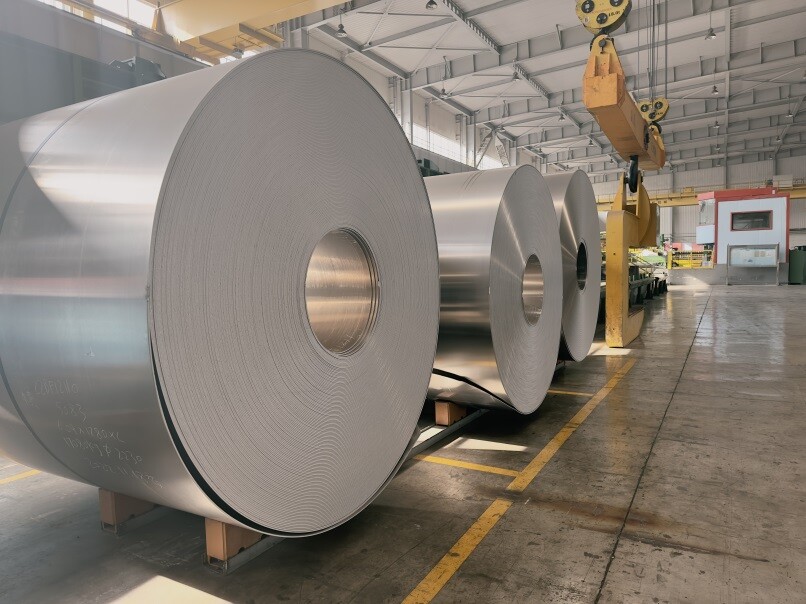The cold rolling process of aluminum alloy coils is a metal processing method. The process includes rolling aluminum alloy materials through multiple passes to ensure that the shape and size accuracy meet the requirements. This process has the characteristics of high precision, high efficiency, excellent material performance, good repeatability, wide application range, environmental protection and energy saving. It is an advanced material making method.
In the cold rolling process of aluminum alloy coils, raw materials need to be prepared first, including aluminum alloy materials and corresponding smelting aluminum ingots. The materials are required to be of high purity, have chemical composition that meets the requirements, and have good processing performance and mechanical properties. After heat treatment, the aluminum coil can make its structure denser and improve its ductility and toughness. Generally, the rolling-intermediate heating-cleaning process is used, and the surface of the aluminum coil can also be cleaned and polished.
After heat treatment, the aluminum coil enters the rolling process, including multi-pass rolling and graded rolling. The rolling temperature is generally controlled within a reasonable range, and parameters need to be continuously adjusted during the rolling process to ensure the surface flatness and thickness uniformity of the aluminum coil. In addition, oil coating technology will be used during the rolling process to protect the surface of the aluminum coil from oxidation corrosion. After rolling, the aluminum coil must undergo an annealing process to restore its internal stress, structure and hardness. The annealing temperature is generally between 200-250℃, and the time and temperature should be determined according to the specific situation.
The annealed aluminum coils need to be cut and coiled to meet customer requirements for aluminum coils of fixed sizes and lengths. Dimensional deviations need to be strictly controlled during cutting to avoid waste and material.
In general, the cold rolling process of aluminum alloy coils involves multiple links and complex parameter control, which requires professional technical personnel to operate and manage.
The key process and control elements of cold rolling of aluminum alloy coils include the following aspects:
Selection and adjustment of rolling machinery: The basis of the cold rolling process is the selection of appropriate rolling machinery and precise adjustment. Different rolling machines are suitable for different aluminum plate thicknesses and hardnesses, so it is necessary to select a suitable rolling mill according to product requirements. At the same time, the rolling mill needs to be adjusted accurately before rolling to ensure the stability and accuracy of rolling.
Design and manufacturing of rolling rolls: Rolling rolls are an important part of the cold rolling process, and their design and manufacturing quality have an important impact on product performance. Factors such as roll material, shape, size, etc. need to be fully considered to ensure stability and accuracy during the rolling process.
Selection and use of rolling lubricants: Lubricants are needed during the cold rolling process to reduce rolling force and friction, improve rolling efficiency and product surface quality. Therefore, it is necessary to select suitable lubricants based on product characteristics and process requirements, and strictly control the amount and method of use.
Temperature control during the rolling process: During the cold rolling process, temperature control has an important impact on product performance. Too high a temperature can cause material deformation and surface quality degradation, while too low a temperature can cause material cracking and fracture. Therefore, the temperature during the rolling process needs to be strictly controlled and adjusted as needed.
Surface treatment: There may be defects or impurities on the surface of cold-rolled aluminum alloy coils, and surface treatment is required to improve the appearance and quality of the product. Common surface treatment methods include grinding, polishing, sandblasting, etc.
Quality inspection: After each production link, strict quality inspection is required to ensure that the various indicators of the product meet the requirements. The inspection content includes size, shape, surface quality, mechanical properties, etc.
The key process and control elements of cold rolling of aluminum alloy coils cover many aspects such as equipment selection and adjustment, roll design and manufacturing, lubricant selection and use, temperature control, surface treatment and quality inspection. These links are interrelated and influence each other, and require overall consideration and careful operation to ensure the quality and performance of the final product.
The key processes of cold rolling aluminum alloy coils have the following characteristics:
High precision: The deformation amount and rolling speed of the cold rolling process are small, making the material more precise and the surface smoother.
High efficiency: The cold rolling process requires less energy, has a long service life, and has less labor intensity for workers, so the cost is lower.
Excellent material properties: After cold rolling process, the hardness, tensile strength, ductility, surface quality and other properties of the material have been improved.
Good repeatability: The cold rolling production process has the characteristics of stability, reliability and good repeatability, which can ensure the production of materials of the same specifications and quality.
Wide scope of application: The cold rolling production process can be applied to various metal materials, such as iron, steel, aluminum and metal alloys, and can produce various complex product shapes and sizes.
Environmental protection and energy saving: The cold rolling process is carried out at normal temperature and does not require heating, reducing energy consumption and environmental pollution.
In summary, the key process of cold rolling aluminum alloy coils has the characteristics of high precision, high efficiency, excellent material properties, good repeatability, wide application range, environmental protection and energy saving. It is an advanced material making method, and has a wide application prospect and market demand.
Post time: Jul-23-2024


